If you’re looking for a dog that’s athletic, intelligent, and bursting with personality, the Siberian Husky might just be your perfect match! These wolf-like beauties originated in Siberia. Their endurance, speed, and teamwork made them invaluable in the Arctic, and their friendly nature made them great companions.
Huskies are natural-born adventurers with boundless energy and a love for the outdoors. These dogs are built to run for miles and thrive on long walks, hikes, and even dog sports like canicross or skijoring. They’re incredibly social, love being part of a “pack” (which includes you!), and are known for their playful, mischievous streak.
They’re highly intelligent but also independent, meaning they’ll listen to you… if they feel like it! Training requires patience and consistency, but once you establish a bond, they’ll amaze you with their skills and loyalty. Just be ready for a lot of talking—Huskies are famous for their dramatic howls and “conversations” with their humans.
If you live in a hot climate, be extra cautious—Huskies have a thick double coat that keeps them warm in the cold but can cause overheating in high temperatures. Despite their fluffy appearance, they’re actually very clean dogs with minimal doggy odor, though they shed like crazy, especially during seasonal coat blows.
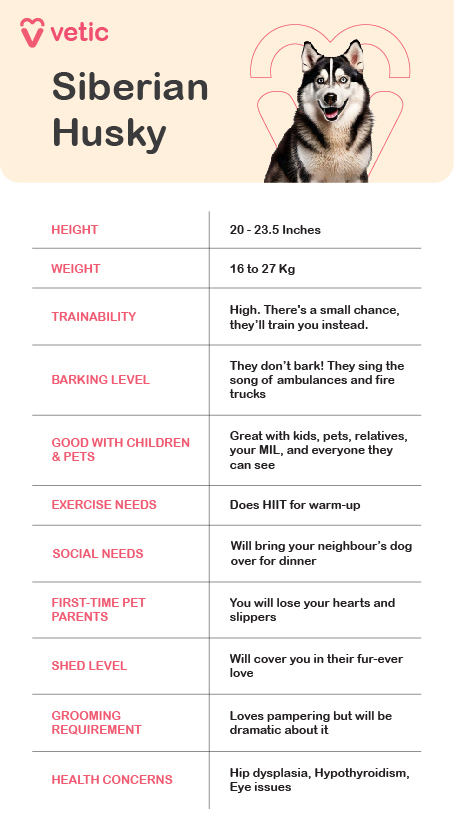
Complete Nutrition and Feeding Guide for Husky Puppy
Nutritional Needs of Your Husky Pup:
Husky puppies are medium-sized, highly energetic, and built for endurance. Their diet should focus on balanced nutrition to support their rapid growth, joint health, strong muscles, and a thick double coat, while considering their predisposition to hip dysplasia, eye issues, and hypothyroidism.
- Protein: High-quality animal-based proteins like chicken, turkey, lamb, or fish are essential for muscle development. As Huskies are highly active, protein should make up a significant portion of their diet to support their stamina and lean muscle mass.
- Fats: Essential fatty acids like omega-3 and omega-6 promote a healthy, water-resistant coat and reduce inflammation, benefiting both their skin and joints. Fish oil and flaxseed are excellent sources.
- Carbohydrates: Huskies have efficient metabolisms, meaning they do not require excessive carbohydrates. Opt for complex carbs like brown rice, quinoa, or sweet potatoes to provide sustainable energy without causing unnecessary weight gain.
- Vitamins and Minerals:
- Calcium and phosphorus support strong bones and joints, crucial for preventing hip dysplasia.
- Vitamin A promotes good vision, reducing the risk of common eye disorders.
- Iodine is vital for thyroid function, as Huskies are prone to hypothyroidism.
- Hydration: Huskies are not naturally big drinkers, so ensure they always have access to fresh water and consider moisture-rich foods to keep them well-hydrated.
Food Options for Your Husky Puppy:
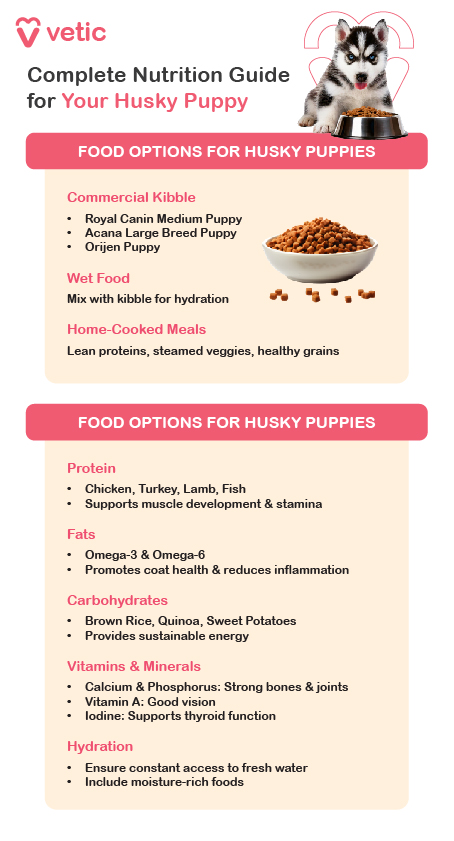
Commercial Kibble:
Choose a high-quality puppy food designed for medium to large breeds, such as Royal Canin Medium Puppy or Orijen Puppy. These options provide the necessary nutrients to support healthy growth and strong joints.
Wet Food:
While not mandatory, wet food can be beneficial in ensuring proper hydration. Look for puppy-specific formulas that meet AAFCO guidelines, and mix them with kibble to encourage chewing and digestion.
Home-Cooked Meals:
Consult a veterinarian for a balanced homemade recipe. Include lean proteins (chicken, turkey, fish), steamed vegetables (carrots, spinach), and healthy grains (quinoa, brown rice). Avoid high-fat meats and toxic foods like onions, garlic, and chocolate.
Treats:
Use high-protein, low-calorie treats for training, such as freeze-dried meat or dental chews. Limit treats to 10% of daily caloric intake to prevent unnecessary weight gain.
Feeding Plan and Timing for Husky Puppies:
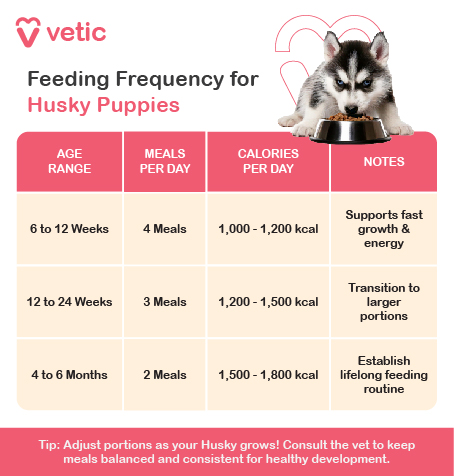
- 6 to 12 Weeks: Feed 4 small meals a day to support their fast growth and high energy levels.
- 12 to 24 Weeks: Transition to 3 meals a day as they grow and can handle larger portions.
- 4 to 6 Months: Reduce to 2 meals a day, establishing a lifelong feeding routine.
Additional Tips for Husky Puppies:
- Joint Health: Consider adding glucosamine and chondroitin supplements early to support developing joints and prevent hip dysplasia.
- Portion Control: Huskies self-regulate their food intake better than many breeds but still monitor their portions to prevent obesity, which can strain their joints.
- Consistent Feeding Schedule: Feed at the same times daily to establish a routine and aid digestion.
- Avoid Overfeeding Carbs: Since Huskies store energy efficiently, too many carbohydrates can lead to weight gain and lethargy.
- Monitor Allergies: Look out for itching, digestive issues, or coat dullness, which may indicate food sensitivities. Consult your vet for hypoallergenic diet options if needed.
Grooming Needs and Maintenance for Husky Puppies
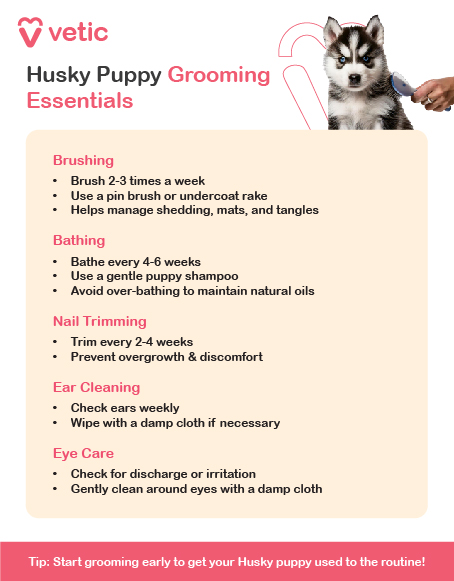
Coat Care
The thick double coat of a Siberian Husky puppy requires regular grooming to manage shedding and maintain coat health:
- Brushing: Huskies shed heavily, even as puppies. Brush 3–4 times a week using an undercoat rake or slicker brush to remove loose fur and prevent matting. Daily brushing is ideal during seasonal shedding periods.
- Bathing: Huskies have a self-cleaning coat and do not develop the typical “doggy” odor. Bathe only when necessary, typically every 2–3 months, using a mild, hypoallergenic puppy shampoo. Overbathing can strip natural oils and dry out their skin.
- Skin Checks: Inspect their skin for signs of dryness, redness, or parasites, especially during grooming sessions. Their dense coat can hide skin issues.
Ear Care
Huskies have erect ears, reducing the risk of infections compared to floppy-eared breeds, but regular maintenance is still essential:
- Weekly Cleaning: Use a vet-approved ear cleaner and a cotton ball to remove wax and debris. Avoid inserting anything deep into the ear canal.
- Monitor for Discomfort: Look out for excessive scratching, head shaking, foul odor, or redness, which could indicate an infection. Keep ears dry, especially after baths.
Nail Trimming
Trim your Husky puppy’s nails every 3–4 weeks. Overgrown nails can cause discomfort and affect their posture and movement. If you hear clicking sounds when they walk on hard floors, it’s time for a trim.
Dental Hygiene
- Brushing: Start brushing their teeth 2–3 times a week with dog-safe toothpaste to prevent tartar buildup and maintain oral health.
- Chew Toys: Provide sturdy chew toys or dental treats to help clean teeth naturally and support jaw strength.
Preventive Care and Vaccines Husky Puppies
Vaccination Guidelines for Husky Puppies
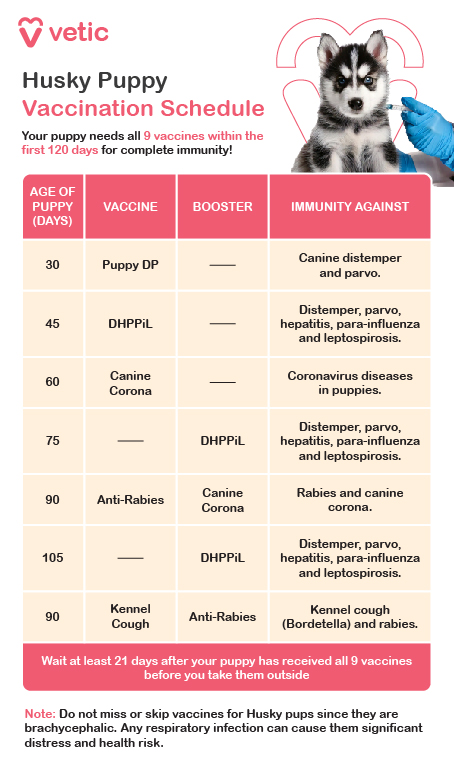
Husky puppies are energetic and love social interactions, making preventive care crucial for their health:
- 6–8 Weeks: First vaccines for Distemper, Parvovirus.
- 10–12 Weeks: Booster doses for Distemper, Parvovirus, Leptospirosis, Hepatitis, and Parainfluenza (9-in-1). Rabies vaccination may be required depending on local laws.
- 14–16 Weeks: Final round of core vaccinations, including Rabies if not yet administered.
- 6 Months: Optional vaccines such as Kennel Cough and Canine Corona, depending on environmental exposure.
Parasite Control for Husky Puppies
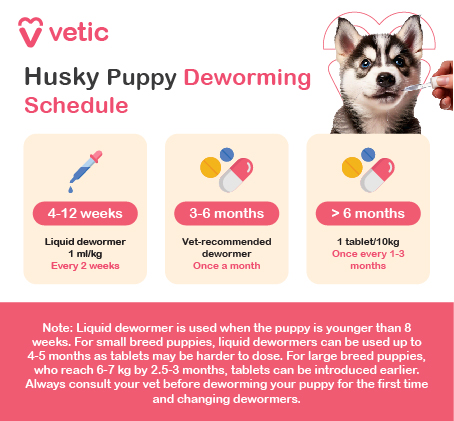
- Flea and Tick Prevention: Start a vet-approved treatment at 8 weeks, as their thick fur can make it easier for parasites to hide.
- Heartworm Prevention: Begin monthly heartworm medication by 12 weeks, especially in regions with a high prevalence.
- Routine Vet Visits: Schedule check-ups every 3–4 weeks during the first 6 months to monitor growth and address any emerging health concerns.
Health Risks and Warning Signs in Husky Puppies
Common Health Concerns for Husky Puppies
Siberian Huskies are generally a healthy breed but are predisposed to certain genetic conditions:
- Hip Dysplasia: A genetic condition that can lead to arthritis later in life. Ensure proper nutrition and avoid excessive high-impact activities during growth.
- Eye Issues: Huskies are prone to cataracts, progressive retinal atrophy (PRA), and corneal dystrophy. Regular eye check-ups can help detect issues early.
- Hypothyroidism: Some Huskies may develop hypothyroidism, leading to weight gain, lethargy, and coat thinning. Monitor their energy levels and coat condition.
- Zinc Deficiency: This breed can have difficulty absorbing zinc, leading to skin lesions or dull fur. A balanced diet with appropriate supplementation, if needed, can help.
- Gastrointestinal Sensitivities: Some Husky puppies have sensitive stomachs. Introduce new foods gradually and stick to a high-quality, protein-rich diet.
Signs to Monitor for Husky Health Troubles
- Difficulty walking, stiffness, or reluctance to move (possible joint issues)
- Cloudy eyes, excessive tearing, or vision impairment
- Unexplained weight gain or lethargy (potential thyroid issues)
- Persistent itching, dry skin, or patches of hair loss (zinc deficiency or allergies)
- Vomiting, diarrhea, or reduced appetite
Seek veterinary care promptly if any of these symptoms appear to prevent complications and ensure your Husky puppy grows up strong and healthy.
Physical Activities for Your Siberian Husky Puppy
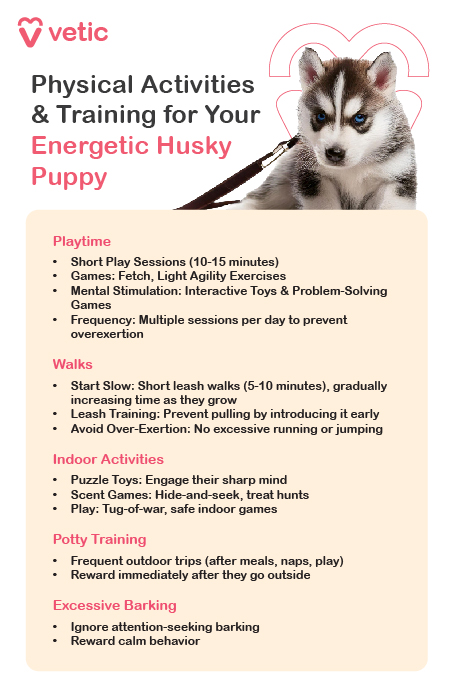
Siberian Husky puppies are highly energetic and playful. As a working breed, they require both physical and mental stimulation from an early age. However, since they are still growing, their exercise should be moderate and appropriate for their developing joints.
Playtime for Husky Puppy
- Engage in short but frequent play sessions, such as fetch, tug-of-war, or light agility exercises.
- Huskies love problem-solving games, so try interactive toys that challenge them mentally.
- Keep sessions around 10–15 minutes, multiple times a day, to prevent overexertion.
Walks for Husky Puppy
- Start with short leash walks of about 5–10 minutes, gradually increasing as they grow.
- Huskies are natural pullers, so introduce leash training early to prevent bad habits.
- Avoid excessive running or jumping, as their joints are still developing.
Indoor Activities
- Provide puzzle toys and scent-based games to engage their sharp minds.
- Hide-and-seek is a great way to burn energy indoors on hot or rainy days.
Training Your Siberian Husky Puppy
Huskies are independent and intelligent but can also be stubborn. Early training using positive reinforcement is key to shaping their behavior.
Potty Training
- Take your puppy outside frequently, especially after meals, naps, and play.
- Establish a consistent potty area and reward them immediately after they go.
- If accidents happen, avoid punishment—simply clean up and reinforce the correct behavior.
Example: If your Husky puppy successfully eliminates outside, immediately praise them and offer a small treat to reinforce the habit.
Leash Training
- Use a front-clip harness to discourage pulling.
- Reward them for walking beside you instead of pulling ahead.
- Practice in a distraction-free environment before progressing to busier areas.
Example: If your puppy starts pulling, stop walking. Only move forward when the leash is loose to teach them that pulling won’t get them anywhere.
Teaching Them Not to Bark Too Much
Huskies are vocal and love to “talk,” but excessive barking should be managed early.
- Ignore attention-seeking barking and reward calm behavior.
- Teach the “quiet” command by rewarding them when they stop barking on cue.
- Provide plenty of mental and physical exercise to reduce excessive vocalization.
Example: If your puppy barks excessively, wait for a pause, then say “quiet” and reward them with a treat when they stay silent for a few seconds.
Common Behavioral Problems in Husky Puppies and Solutions
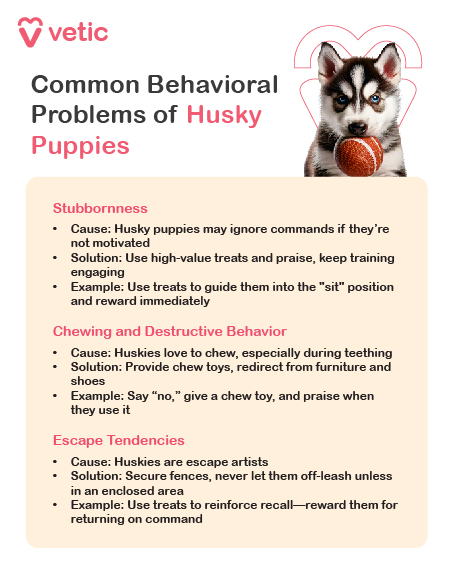
Stubbornness
- Huskies may refuse commands if they don’t see a reason to follow them.
- Use high-value treats and praise to make training more rewarding.
- Keep sessions short and engaging to maintain their interest.
Example: If your Husky ignores the “sit” command, use a treat to guide them into position, reward immediately, and keep training fun.
Chewing and Destructive Behavior
- Huskies love to chew, especially during teething.
- Provide plenty of chew toys and rotate them for variety.
- Redirect them from furniture or shoes to an appropriate chew toy.
Example: If your puppy starts chewing on the furniture, say “no” firmly, give them a chew toy, and praise them when they use it.
Escape Tendencies
- Huskies are natural escape artists, so secure your home with high fences and supervised playtime.
- Never let them off-leash in an open area unless it’s fully enclosed.
- Teach a strong recall command early on.
Example: Use high-value treats when practicing recall—call their name excitedly, reward them when they come, and never punish them for returning late.
Mental Stimulation for Siberian Husky Puppies
Huskies require more than just physical exercise—they need mental challenges to stay happy and prevent destructive behavior.
Puzzle Toys and Games
- Use treat-dispensing puzzles to keep them mentally engaged.
- Play games like “find the treat” to encourage problem-solving.
Obedience and Trick Training
- Teaching tricks like “shake” and “roll over” can help keep their minds active.
- Reward-based training helps prevent stubbornness and reinforces good behavior.
By focusing on positive reinforcement, consistency, and mental stimulation, you can help your Siberian Husky puppy develop into a well-behaved, happy companion.
Comprehensive Care for Junior Huskies
Nutrition for Junior Siberian Huskies (6 to 18 Months)
Siberian Huskies are high-energy, athletic dogs with unique nutritional requirements. During their junior stage (6 to 18 months), they continue to grow while maintaining an active lifestyle. A well-balanced diet supports muscle development, joint health, and sustained energy levels.
Essential Nutritional Needs of Junior Huskies
Protein
Huskies require a high-protein diet to maintain muscle mass and energy. Aim for 25-30% high-quality animal protein from sources like:
- Chicken, turkey, lamb, or fish
- Eggs for additional amino acids
- Organ meats (liver, heart) in moderation
Healthy Fats
Fats are essential for energy and maintaining a healthy coat. Huskies thrive on Omega-3 and Omega-6 fatty acids, which can be found in:
- Salmon, flaxseed, or fish oil (for skin and coat health)
- Chicken fat for energy and palatability
- Coconut oil in small amounts for digestive health
Complex Carbohydrates
Due to their endurance and energy levels, Huskies need slow-releasing carbs, such as:
- Brown rice, quinoa, or oats
- Sweet potatoes and pumpkin for fiber and digestion
- Peas and lentils for plant-based energy
Vitamins and Minerals
Joint and Bone Support
Huskies are prone to hip dysplasia, so their diet should include:
- Calcium and phosphorus (for bone strength) from dairy, fish, or fortified foods
- Glucosamine and chondroitin (for joint health) from bone broth or supplements
Eye and Skin Health
Huskies can be prone to eye conditions like cataracts. Include:
- Vitamin A (from carrots and spinach) for eye support
- Zinc (from fish and beef) to prevent skin and coat issues
- Vitamin E (from nuts and seeds) for immune function
Digestive Health
Sensitive stomachs are common in Huskies, so prioritize:
- Probiotics and fiber (from yogurt and pumpkin) to support digestion
- Vitamin B-complex (from whole grains and meats) for metabolic function
Recommended Food Options
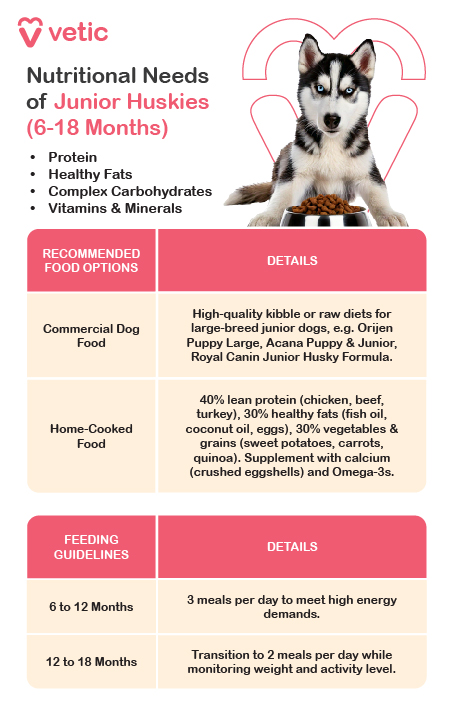
Commercial Dog Food
Opt for high-quality kibble or raw diets formulated for large-breed junior dogs. Brands like:
- Orijen Puppy Large
- Acana Puppy Junior Dog Food
- Arden Grange Puppy Junior
Raw or Home-Cooked Diet
For a balanced home-cooked meal, include:
- 40% lean protein (chicken, beef, turkey)
- 30% healthy fats (fish oil, coconut oil, eggs)
- 30% vegetables and grains (sweet potatoes, carrots, quinoa)
- Supplement with calcium (crushed eggshells) and Omega-3s
Feeding Guidelines for Junior Huskies
- 6 to 12 Months: Feed 3 meals per day to meet high energy demands.
- 12 to 18 Months: Transition to 2 meals per day while monitoring weight and activity level.
- Always provide fresh water to prevent dehydration.
Additional Tips
- Avoid overfeeding to prevent obesity, which Huskies are prone to despite their lean build.
- Never feed table scraps, processed foods, or toxic foods like chocolate, onions, and grapes.
- Stick to a consistent feeding schedule to support digestion and energy balance.
By following these nutritional guidelines, your junior Husky will have the foundation for strong muscles, joint health, and boundless energy as they grow into their adult years.
Grooming Necessities and Frequency for Junior Huskies (6 to 18 Months)
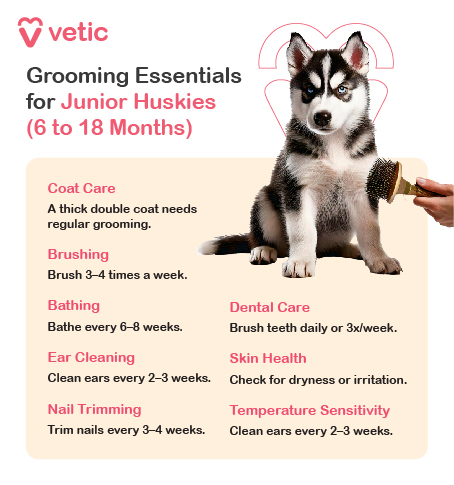
Coat Care for Husky
Huskies have a thick double coat that helps regulate their body temperature, making regular grooming essential to maintain its health and manage shedding.
- Brushing: Brush at least 3–4 times a week with a slicker brush or undercoat rake to remove loose fur and prevent matting, especially during shedding seasons.
- Bathing: Bathe every 6–8 weeks using a mild, dog-specific shampoo. Overbathing can strip natural oils, leading to dry skin.
- Blow Drying: Use a high-velocity dryer after bathing to remove loose hair and prevent moisture buildup in their dense coat.
Ear Cleaning
Huskies have upright ears, reducing the risk of infections compared to floppy-eared breeds, but regular cleaning is still necessary.
- Clean every 2–3 weeks with a vet-approved ear-cleaning solution.
- Check for wax buildup, redness, or bad odor, which could indicate an infection.
Nail Trimming
- Trim nails every 3–4 weeks to prevent discomfort or changes in gait.
- If unsure, consult a groomer or veterinarian for proper trimming.
Dental Care
- Brushing: Brush teeth daily or at least 3 times a week using dog-safe toothpaste to prevent tartar buildup.
- Chews and Toys: Provide vet-recommended dental chews or toys to promote oral hygiene.
Special Considerations for Huskies
- Shedding: Huskies experience heavy seasonal shedding (blowing coat). Increase brushing frequency during these times to manage fur loss.
- Skin Health: Regularly check for dryness, irritation, or hotspots. Use grooming products formulated for sensitive skin if needed.
- Temperature Sensitivity: Huskies are built for colder climates. Avoid excessive outdoor activity in hot weather and provide access to cool areas during summer.
By maintaining this grooming routine, your Junior Husky will stay comfortable, clean, and healthy throughout their development.
Preventive Care and Vaccination Schedule for Junior Huskies (6 to 18 Months)
Vaccination Needs for Junior Huskies
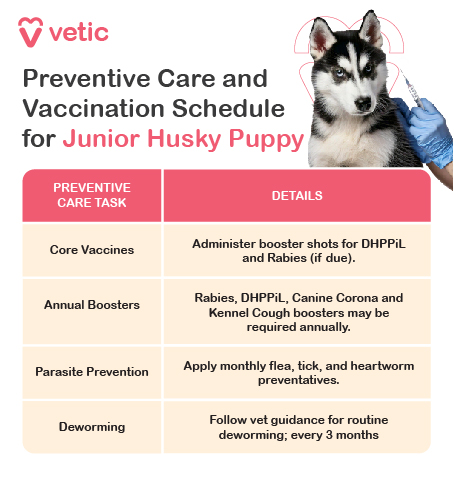
By the time your Husky reaches junior age (6 to 18 months), their core vaccinations should be completed, but booster shots and additional vaccines may still be required based on your location and veterinary recommendations.
Core Vaccines:
- 6–12 Months: Administer booster shots for DHPPiL (Distemper, Hepatitis, Parvovirus, Parainfluenza, and Leptospirosis), and Rabies.
- Annual Boosters: Rabies, DHPPiL, Kennel Cough and Canine Corona boosters may be required yearly. Always consult your veterinarian.
Parasite Prevention
- Flea and Tick Control: Apply monthly preventatives to protect your Husky from parasites and vector-borne diseases.
- Heartworm Prevention: Continue monthly heartworm preventatives, particularly in regions with a high risk.
- Deworming: Follow veterinary guidance for routine deworming to prevent intestinal parasites.
Routine Vet Check-ups
Schedule veterinary visits every 6 months to:
- Monitor weight, growth, and body condition.
- Address any changes in energy levels, appetite, or coat health.
- Detect early signs of breed-specific health concerns.
Common Health Risks in Junior Huskies
- Hip Dysplasia: A common concern in larger breeds. Maintain a healthy weight and provide joint-supportive nutrition.
- Eye Issues: Huskies are prone to cataracts and progressive retinal atrophy. Regular vet checkups can help with early detection.
- Zinc Deficiency: Huskies have a genetic predisposition to zinc-responsive dermatosis. Ensure their diet includes adequate zinc levels.
- Gastric Torsion (Bloat): Avoid feeding large meals before or after exercise to reduce the risk of bloat and torsion.
Signs to Watch For
- Sudden limping, reluctance to run or jump.
- Cloudy eyes, excessive tearing, or vision changes.
- Patchy fur loss, redness, or excessive itching.
- Lethargy, drastic weight gain or loss.
- Vomiting, bloating, or irregular bowel movements.
When to Contact Your Veterinarian Seek immediate veterinary attention if your Husky exhibits:
- Difficulty walking, stiffness, or signs of joint pain.
- Excessive panting or heat intolerance.
- Persistent vomiting, diarrhea, or bloating.
- Changes in behavior, appetite, or hydration levels.
By following a consistent preventive care plan, you can ensure your Junior Husky grows into a strong, healthy, and energetic adult.
Activities, Exercise, and Training for Junior Huskies (6 to 18 Months)
Physical Activities for Junior Huskies
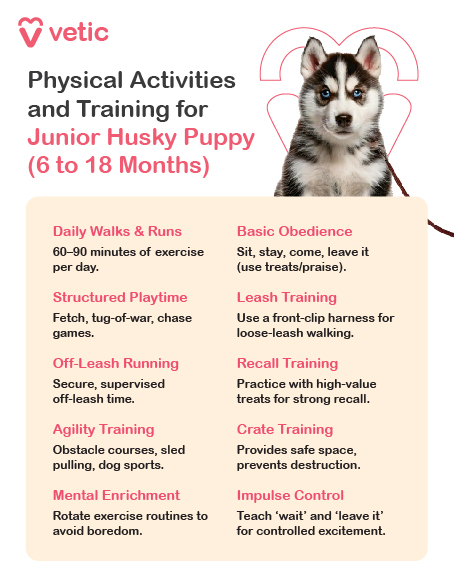
Junior Huskies are a high-energy, working breed that requires consistent physical and mental stimulation. Without adequate exercise, they may develop destructive behaviors due to boredom.
- Daily Walks & Runs: Huskies need at least 60–90 minutes of exercise daily. Two long walks or a combination of walking, running, and hiking is ideal to meet their energy needs.
- Structured Playtime: Engage in activities like fetch, or chase games to burn excess energy.
- Off-Leash Running: If you have access to a secure fenced area, allow supervised off-leash running to satisfy their natural desire to roam.
- Agility Training: Huskies thrive in agility courses, obstacle training, or dog sports like canicross and sled pulling to channel their working instincts.
- Mental Enrichment: Rotate different exercise routines to prevent boredom and keep them engaged.
Training Your Junior Husky
Huskies are intelligent but independent, making training a challenge. They respond best to positive reinforcement and consistency.
- Basic Obedience: Teach essential commands like sit, stay, come, and leave it. Huskies are strong-willed, so repetition and rewards (treats, praise, or play) work best.
- Leash Training: Huskies are natural pullers. Use a front-clip harness and reinforce loose-leash walking with commands and rewards.
- Recall Training: Due to their strong prey drive, Huskies may ignore recall commands. Practice in enclosed areas with high-value treats to reinforce coming when called.
- Crate Training: A crate can provide a safe space and prevent destructive behaviors when unsupervised.
- Impulse Control: Teach ‘wait’ and ‘leave it’ to help them manage their excitement and energy.
Mental Stimulation
Mental exercise is just as important as physical activity for Huskies. Providing enrichment prevents boredom and reduces problem behaviors.
- Puzzle Toys: Interactive feeders and treat-dispensing toys challenge their problem-solving skills.
- Training Games: Engage in hide-and-seek or scent detection games to keep their minds active.
- New Commands & Tricks: Teaching tricks like ‘speak,’ ‘spin,’ or ‘high five’ keeps training engaging.
- Interactive Play: Engage in flirt pole play or teach them to retrieve specific objects.
Behavioral Challenges and Solutions for Junior Huskies
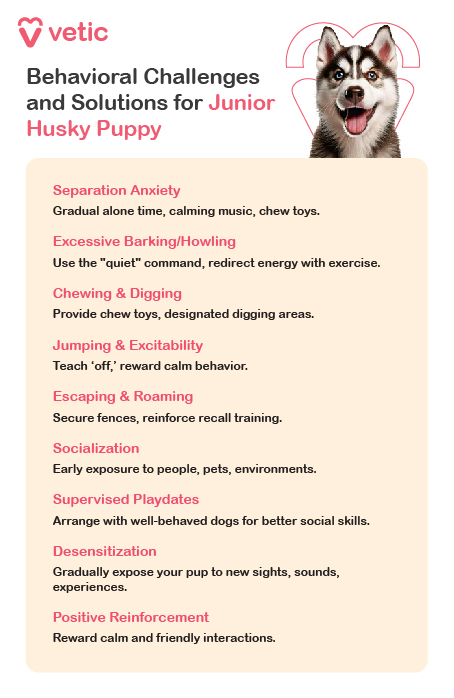
Huskies are known for their vocal nature, stubbornness, and escape tendencies. Addressing these behaviors early is crucial.
- Separation Anxiety: Gradually increase alone time, use calming music, and provide chew toys to ease anxiety.
- Excessive Barking/Howling: Huskies are naturally vocal. Use ‘quiet’ commands with positive reinforcement and redirect their energy with exercise.
- Chewing & Digging: Provide appropriate chew toys and designated digging spots to satisfy their instincts.
- Jumping & Excitability: Teach ‘off’ and reward calm behavior instead of jumping.
- Escaping & Roaming: Huskies are escape artists. Secure fences, avoid leaving them unattended in open spaces, and reinforce recall commands.
Socialization for Your Junior Husky
Proper socialization ensures a well-adjusted, friendly Husky.
- Early Exposure: Introduce them to various environments, people, and pets to build confidence.
- Supervised Playdates: Arrange interactions with other well-behaved dogs to improve social skills.
- Desensitization: Expose them to different sights, sounds, and experiences gradually to prevent fear-based behaviors.
- Positive Reinforcement: Reward calm and friendly interactions to encourage positive social habits.
By balancing exercise, structured training, mental enrichment, and socialization, your Junior Husky will grow into a well-behaved, happy, and thriving companion.
Comprehensive Care Guide for Adult Husky
Complete Nutrition Guide for Adult Huskies
Adult Huskies are energetic, intelligent, and high-endurance dogs that require a well-balanced diet to support their active lifestyle. As a working breed, they have unique dietary needs, including efficient metabolism and a preference for nutrient-dense meals over large portions.
Essential Nutritional Needs of Adult Huskies
Protein: High-quality animal proteins like chicken, turkey, fish, and lean red meats are essential for maintaining muscle mass, stamina, and overall health.
Fats: Healthy fats, particularly omega-3 and omega-6 fatty acids, support brain function, energy levels, and a healthy coat. Sources include fish oil, flaxseed, and chicken fat.
Carbohydrates: Huskies require moderate amounts of complex carbohydrates like brown rice, sweet potatoes, and oats to provide sustained energy without excessive weight gain.
Vitamins and Minerals:
- Calcium and Phosphorus: Essential for bone health and joint strength, particularly for active Huskies.
- Vitamin B Complex: Supports energy metabolism and nervous system health, keeping Huskies alert and responsive.
- Zinc: Crucial for maintaining a healthy coat and skin, as Huskies are prone to zinc deficiencies.
- Vitamin E & C: Antioxidants that boost immune health and support recovery from physical exertion.
Recommended Food Options
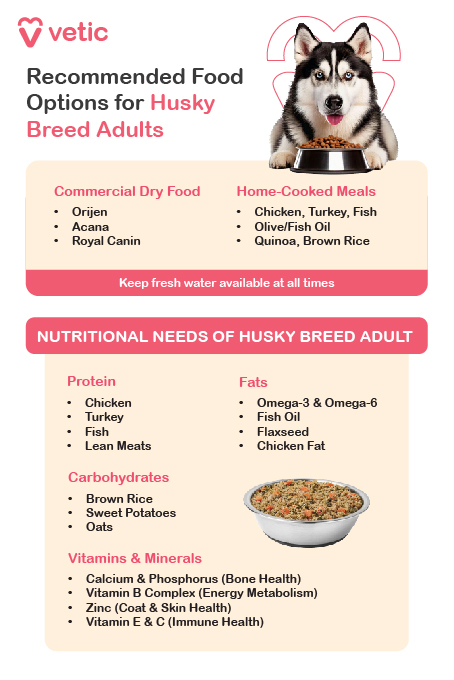
Commercial Dry Food: Opt for high-protein, grain-inclusive formulas designed for active and working breeds. Brands like Orijen, Acana, and Royal Canin Husky are well-suited to their needs.
Home-Cooked Meals: Prepare meals using lean proteins (chicken, turkey, fish), healthy fats (olive oil, fish oil), and digestible carbs (quinoa, brown rice). Always consult a vet to ensure a balanced diet.
Feeding Guidelines for Adult Huskies
Portion Control: Unlike some breeds, Huskies are natural self-regulators and will not overeat if provided appropriate portions. Adjust food intake based on activity levels and body condition.
Meal Frequency:
- 1 to 2 Years: 2 meals per day to maintain stable energy levels.
- 2+ Years: 1 or 2 meals per day, depending on exercise routine and preference.
Hydration:
- Huskies have a thick coat and can be prone to overheating, so ensure access to fresh, clean water at all times.
Additional Feeding Tips:
- Avoid overfeeding, as Huskies are prone to weight gain if they consume more than they burn.
- Do not rely on free-feeding; maintain structured meal times to encourage good eating habits.
- Rotate protein sources occasionally to prevent food boredom and ensure balanced nutrient intake.
By following these nutritional guidelines, your adult Husky will maintain optimal health, energy, and endurance, ensuring a long, happy, and active life.
Grooming Necessities and Frequency for Adult Huskies
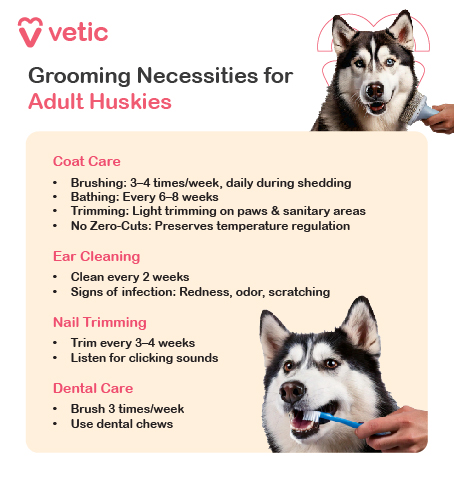
Coat Care for Husky
Huskies have a thick double coat designed to regulate their body temperature in both hot and cold weather. Their fur should never be trimmed too short, as the undercoat acts as an air pocket that helps cool their bodies. Regular grooming is essential to manage their heavy shedding and prevent matting.
- Brushing: Brush thoroughly at least 3–4 times a week using an undercoat rake or de-shedding tool to remove loose fur, prevent tangles, and reduce shedding. During peak shedding seasons (spring and fall), daily brushing is ideal.
- Bathing: Bathe once every 6–8 weeks using a mild, hypoallergenic dog shampoo. Overbathing can strip natural oils, leading to dry skin.
- Trimming: Huskies do not need body trimming, but light trimming around the paws and sanitary areas can help maintain hygiene. Never shave their coat, as it disrupts their natural temperature regulation.
Ear Cleaning
Huskies have upright ears that allow good airflow, reducing the risk of infections. However, regular cleaning is still necessary.
- Frequency: Clean every 2 weeks using a vet-approved ear-cleaning solution.
- Signs of Infection: Redness, odor, excessive scratching, or head shaking indicate potential ear infections. Seek veterinary care if these symptoms appear.
Nail Trimming
Huskies are active dogs, and their nails naturally wear down with exercise. However, indoor dogs or those on softer terrain may need manual trimming.
- Trim every 3–4 weeks to prevent discomfort and improper gait.
- If you hear their nails clicking on hard surfaces, it’s time for a trim.
Dental Care
Huskies are prone to plaque buildup, gum disease, and bad breath if their teeth are not properly maintained.
- Brushing: Brush at least 3 times a week using dog-specific toothpaste and a soft brush.
- Chews and Toys: Provide dental chews or toys designed to reduce tartar buildup.
Special Considerations for Huskies
- Heavy Shedding: Expect seasonal “blowouts” twice a year, requiring extra brushing sessions.
- Flea and Skin Protection: Their thick coat makes them prone to flea infestations and dermatitis. Use flea preventatives and check for skin irritations regularly.
- Heat Sensitivity: Huskies do not tolerate hot weather well. Ensure shade, fresh water, and cooling mats in warm climates, and never over-exercise them in high temperatures.
By following this grooming routine, your Husky will remain healthy, comfortable, and looking their best year-round.
Preventive Care and Vaccination Schedule for Adult Huskies
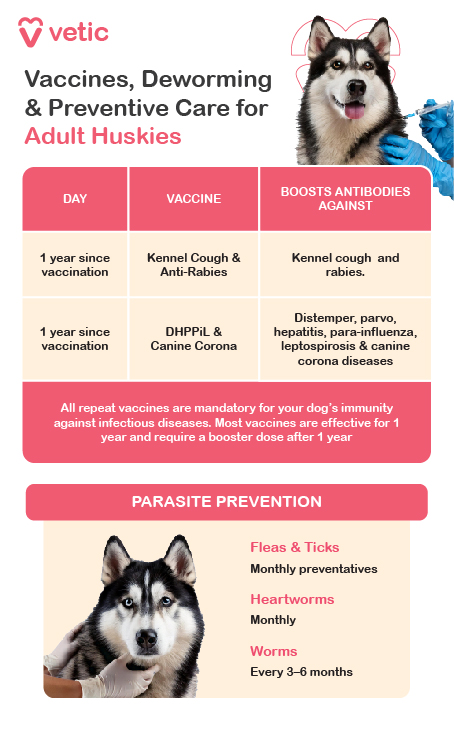
Vaccination Needs for Adult Huskies
By adulthood, Huskies should have received their core vaccinations. However, boosters and additional vaccines may be needed based on their lifestyle and exposure risks.
Core Vaccines:
- Annual Boosters: DHPPiL (Distemper, Hepatitis, Parvovirus, Parainfluenza, and Leptospirosis) and Rabies are required yearly.
- Kennel Cough: Kennel Cough vaccine is recommended for Huskies that visit dog parks, boarding facilities, or training centers.
Parasite Prevention
Huskies are active and love the outdoors, making them susceptible to parasites. A consistent prevention plan is essential.
- Flea and Tick Control: Apply monthly flea and tick preventatives to protect against infestations.
- Heartworm Prevention: Huskies should be given monthly heartworm preventatives, especially in regions with mosquito activity.
- Deworming: Regular deworming every 3–6 months helps prevent intestinal parasites.
Routine Vet Check-ups
Huskies should have a full veterinary check-up every 6 months to:
- Monitor weight, coat health, and overall condition.
- Address any behavioral or dietary changes.
- Detect early signs of breed-specific health concerns.
Common Health Risks in Adult Huskies
- Skin Issues: Huskies are prone to dermatitis and hot spots, especially in humid climates. Regular grooming and flea control help prevent skin infections.
- Dental Disease: Lack of regular brushing can lead to tartar buildup, gum infections, and tooth loss. Maintain a strict dental care routine.
- Obesity: While Huskies are energetic, overfeeding and lack of exercise can lead to weight gain, which strains their joints. Stick to a well-balanced diet.
- Hip Dysplasia: Large, active breeds like Huskies are prone to joint issues. Maintain a healthy weight and consider supplements like glucosamine and chondroitin for joint support.
- Eye Problems: Huskies can develop cataracts, corneal dystrophy, and progressive retinal atrophy. Routine vet visits can help detect these early.
Signs to Watch For
- Excessive scratching, hair loss, or skin redness.
- Changes in appetite, weight, or energy levels.
- Limping, difficulty getting up, or stiffness.
- Bad breath, swollen gums, or reluctance to eat.
- Heavy panting or struggling in hot weather.
- Vomiting, diarrhea, or changes in stool.
When to Contact Your Veterinarian
Seek immediate attention if your Husky exhibits:
- Difficulty breathing or excessive panting in warm conditions.
- Persistent vomiting or diarrhea lasting over 24 hours.
- Lethargy, reluctance to move, or signs of joint pain.
- Sudden loss of vision or eye cloudiness.
By staying proactive with preventive care, you can ensure your Husky remains healthy, energetic, and well-protected against common health risks.
Activities, Exercise, and Training for Adult Huskies
Physical Activities for Adult Huskies
Huskies are energetic, athletic dogs that require consistent exercise to stay happy and healthy. Without enough activity, they can become restless and destructive.
- Daily Walks and Runs: Huskies need intense exercise daily. Long walks, jogging, or running sessions are great ways to meet their energy needs.
- Outdoor Play: Engage them in activities like fetch, tug-of-war, or agility training. Secure, fenced areas are essential since Huskies have a strong prey drive and may run off.
- Pulling and Sledding Exercises: Huskies love pulling activities. If possible, involve them in canicross, bikejoring, or urban mushing to tap into their natural instincts.
- Cooler Timing: Since Huskies overheat easily, exercise them during cool mornings or evenings in hot climates. Always provide fresh water and shaded breaks.
Training Your Husky
Huskies are intelligent but independent, making training both rewarding and challenging. Consistency and positive reinforcement are key.
- Basic Commands: Teach essential commands like sit, stay, come, and leave it. Use treats and praise to reinforce good behavior.
- Leash Training: Huskies tend to pull on the leash. Use a no-pull harness and practice controlled walks with rewards for loose-leash walking.
- Recall Training: Huskies have a strong prey drive, making reliable recall training crucial. Start in enclosed areas before testing recall in open spaces.
Mental Stimulation
Huskies are problem-solvers and need mental engagement to prevent boredom and destructive behavior.
- Puzzle Toys: Provide interactive toys that challenge them to solve puzzles for treats.
- Obedience and Trick Training: Teach advanced commands and fun tricks like spin, roll over, or speak to keep their minds engaged.
- Scent Work & Hide-and-Seek: Play hide-and-seek with treats or toys to stimulate their natural hunting instincts.
Behavior Problems and Solutions for Huskies
Huskies are known for their mischievous and sometimes stubborn nature. Proper training and routine can help manage unwanted behaviors.
- Escaping & Roaming: Huskies are escape artists. Ensure your yard has a tall, secure fence with a buried base to prevent digging out.
- Destructive Chewing: Without enough exercise, Huskies may chew furniture or dig. Provide durable chew toys and ample exercise.
- Howling & Vocalization: Huskies are talkative and may howl excessively. Train the “quiet” command and redirect them with engaging activities.
Socialization for Your Husky
Proper socialization helps Huskies develop into well-adjusted, friendly adults.
- Introduce them to different environments, people, and animals from an early age.
- Arrange playdates with other active dogs to encourage healthy social interactions.
- Expose them to new experiences gradually to build confidence and reduce fear-based reactions.
By combining regular physical activity, structured training, mental enrichment, and proper socialization, your Husky will thrive as a well-behaved and happy companion.
Comprehensive Care for Senior Huskies
Senior Husky: Complete Nutritional Guide
As Huskies enter their senior years, typically around 8 years and older, their energy levels, metabolism, and overall health begin to change. Senior Huskies may experience joint stiffness, weight fluctuations, digestive sensitivity, and cognitive decline. By adjusting their diet, exercise routine, and overall care, you can help your Husky stay active and comfortable in their golden years.
Nutritional Needs for Senior Huskies
- Protein: Older Huskies still need high-quality, lean protein to maintain muscle mass and support overall health. Opt for chicken, turkey, fish, or lamb, which are easier to digest.
- Fats: While excessive fat intake can lead to weight gain, omega-3 fatty acids (found in fish oil and flaxseed) help reduce inflammation and support joint health and cognitive function.
- Carbohydrates: Choose easily digestible carbs like brown rice, sweet potatoes, or oatmeal. These provide steady energy without overloading their digestive system.
- Fiber: Since digestive efficiency decreases with age, adding fiber-rich foods (pumpkin, carrots, green beans) can help prevent constipation and support gut health.
Essential Vitamins and Supplements
- Glucosamine and Chondroitin: These joint-supporting supplements help manage arthritis and mobility issues common in senior Huskies.
- Antioxidants (Vitamins C & E): These help boost the immune system and slow cognitive decline.
- Probiotics: Aid in gut health and digestion, preventing issues like bloating or irregular bowel movements.
Recommended Food Options for Senior Huskies
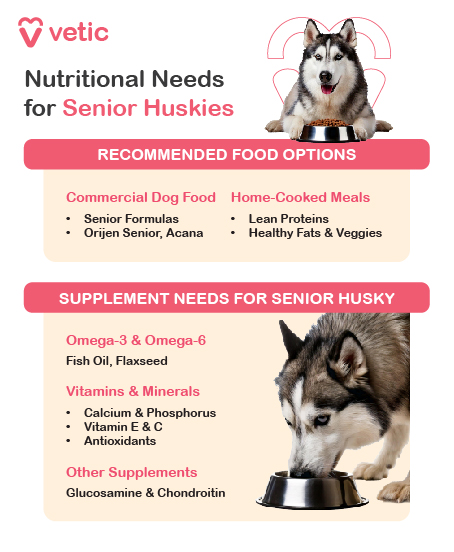
- Senior Dog Food: Look for high-quality senior-specific dog food designed for large breeds, as it contains the right balance of protein, fiber, and joint-supporting nutrients.
- Wet Food: If your Husky has dental issues, switching to wet food or mixing it with kibble can make eating easier while maintaining proper nutrition.
- Home-Cooked Meals: If preparing meals at home, consult a veterinarian to ensure a balanced diet. Include lean meats, vegetables, and whole grains, avoiding harmful ingredients like onions, garlic, and excessive salt.
Feeding Guidelines for Senior Huskies
- Two Smaller Meals Daily: Feeding twice a day instead of once can help maintain steady energy levels and digestion.
- Portion Control: Adjust meal portions based on your Husky’s activity level and weight to prevent obesity or excessive weight loss.
- Hydration: Ensure fresh water is always available, as dehydration can worsen kidney function and contribute to urinary tract issues.
Grooming Necessities for Senior Huskies
As Huskies age, their grooming needs evolve. Maintaining regular grooming routines is essential to keep their coat, skin, and overall health in top shape, especially considering the unique challenges older Huskies face.
Coat Care
- Thinning or Graying Fur: Like many older dogs, senior Huskies may experience a thinning or graying of their fur. This can be more noticeable in their longer outer coat. Regular grooming helps keep the coat looking healthy and prevents matting, which is more common as they age.
- Brushing: Brush your senior Husky at least 3-4 times a week to remove loose hair and prevent tangles. Older Huskies often shed more, and brushing will help minimize shedding around the house while also preventing their thick undercoat from becoming matted.
- Bathing: Bathing is necessary, but you should bathe your senior Husky every 6-8 weeks (or as needed) using a gentle, moisturizing dog shampoo. Their skin tends to become drier with age, and this helps maintain their skin’s moisture balance and reduces itching or discomfort.
- Ear Cleaning: Older Huskies can be more prone to ear infections, especially if they have dense fur in their ears. Make it a habit to clean their ears regularly, using a vet-approved ear cleaner. This can help prevent wax buildup and infections.
- Nail Trimming: Trim their nails every 4-6 weeks. As older Huskies may become less active, their nails might not wear down naturally. Long nails can lead to discomfort or mobility issues, so regular trimming is key.
Dental Care
- Oral Health: Dental care becomes increasingly important as Huskies age. Gum disease, tooth loss, and bad breath are more common in older dogs. Brush your Husky’s teeth 2-3 times a week with a dog-friendly toothpaste to maintain their oral health.
- Alternatives: If brushing is difficult, consider offering dental chews or water additives designed for senior dogs to help reduce tartar buildup and improve their overall dental hygiene.
Regular grooming helps ensure your senior Husky remains comfortable, healthy, and happy in their later years, allowing them to enjoy life as much as possible.
Preventive Care and Health Maintenance for Senior Huskies
As your Husky enters their senior years (around 7 years old and beyond), proactive healthcare becomes critical. Senior Huskies face unique challenges, so adjusting their care routine to meet their evolving needs is vital.
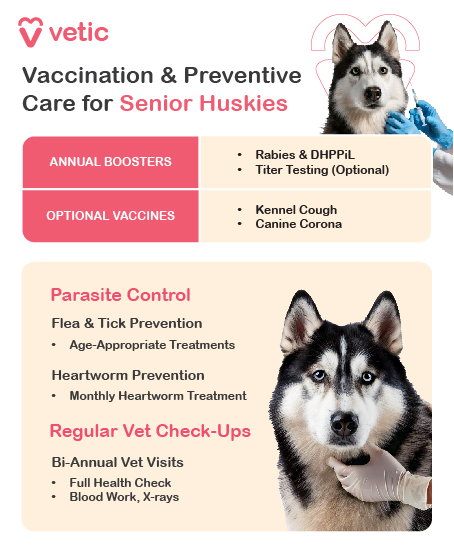
Vaccinations and Preventive Care
- Annual Boosters: Many senior Huskies may receive fewer vaccine boosters. It’s wise to discuss options with your vet, including titer testing (blood tests to check immunity levels) to avoid unnecessary boosters. They should be updated on their rabies and DHPPiL vaccines.
- Optional Vaccines: Depending on your Husky’s environment, additional vaccines such as Kennel Cough and Canine Corona might be considered, especially if your dog frequents high-risk areas like dog parks or hiking trails.
Parasite Control
- Flea and Tick Prevention: Even as seniors, Huskies require flea and tick prevention to avoid health complications. Age-appropriate, vet-approved treatments should be used consistently.
- Heartworm Prevention: Monthly heartworm prevention is essential for senior Huskies. Older dogs are more vulnerable to heartworm disease, so adherence to this schedule is crucial for their health.
Regular Vet Check-Ups
- Bi-Annual Vet Visits: Senior Huskies should visit the vet at least twice a year for a full health check-up. This helps catch potential issues early and allows for monitoring their overall well-being.
- Diagnostic Testing: Your vet may suggest diagnostic tests like blood work, urinalysis, or X-rays to screen for age-related conditions such as arthritis, kidney issues, or heart disease.
Health Risks for Senior Huskies and What to Watch For
As your Husky ages, they may be more prone to specific health concerns. Vigilance in recognizing early signs can make a big difference in effectively managing these conditions.
Common Health Concerns in Senior Huskies
- Arthritis: Just like humans, older Huskies often suffer from joint pain or arthritis. Watch for signs such as limping, stiffness, or reluctance to exercise. Joint supplements, weight management, and anti-inflammatory treatments prescribed by your vet can help manage these symptoms.
- Obesity: Senior Huskies may experience a decrease in activity, which can lead to weight gain. Maintaining a healthy weight is crucial to reducing stress on their joints and supporting overall health. Regular exercise and portion-controlled meals will help prevent obesity.
- Hypothyroidism: This condition is common in older Huskies and can cause symptoms like lethargy, weight gain, or thinning fur. Regular thyroid function tests can help diagnose and treat this condition early.
- Heart Disease: As Huskies age, they may develop heart problems. Look for signs like coughing, difficulty breathing, or excessive tiredness. Early detection through vet visits is essential for managing heart disease effectively.
- Cancer: Like many older dogs, senior Huskies are more prone to developing cancers. Pay attention to any unusual lumps, bumps, or changes in behavior, appetite, or energy levels. Regular check-ups and early detection are critical for a better treatment outcome.
- Cognitive Decline (Canine Cognitive Dysfunction): Senior Huskies may experience cognitive decline, which can lead to confusion, changes in behavior, or disrupted sleep patterns. Providing mental stimulation and consulting your vet about possible treatments can help manage this condition.
Signs to Watch For
- Stiffness or difficulty moving
- Unexplained weight gain or loss
- Coughing, wheezing, or labored breathing
- Changes in appetite or water consumption
- New lumps or growths
- Behavioral changes such as confusion, anxiety, or excessive restlessness
If you observe any of these signs, schedule a veterinary appointment as soon as possible for a comprehensive evaluation.
Activities, Exercise, and Training for Senior Huskies
As your Husky enters their senior years (typically around 7+ years), it’s important to keep them active to maintain their mobility, manage weight, and keep their mind sharp. Senior Huskies may slow down a bit, but with the right activities and adjustments, they can still enjoy a fulfilling and healthy life. Due to their larger size and unique breed traits, exercise for senior Huskies must be carefully tailored to their specific needs.
Physical Activities for Senior Huskies
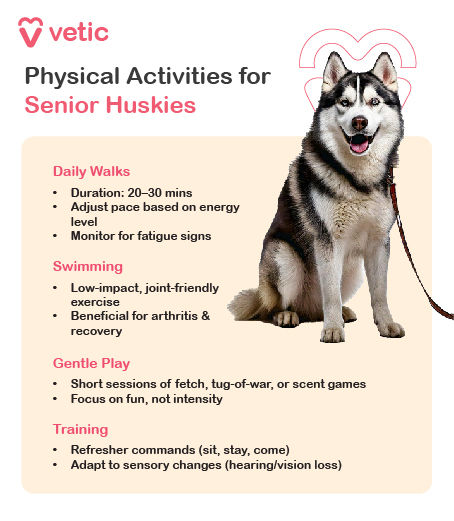
- Daily Walks: Regular walks are crucial to keep your senior Husky active and engaged. However, you should adjust the duration and pace based on your dog’s energy level and physical condition. Aim for 20-30 minutes per walk, once or twice a day. Be mindful of signs of fatigue, such as excessive panting or limping, which may indicate joint pain or exhaustion. Adjust the route to avoid hot pavement or overly strenuous terrain, especially if your Husky is dealing with arthritis or joint issues.
- Swimming: Swimming is a wonderful low-impact exercise for senior Huskies, offering a full-body workout without putting strain on their joints. If your Husky has arthritis or is recovering from surgery, swimming can be especially beneficial. It also allows them to burn off energy and stay fit while being gentle on their bones and muscles.
- Gentle Play: Engage in low-impact play that stimulates your Husky’s mind and body without overexerting them. Consider gentle fetch games, tug-of-war, or scent-based activities that encourage them to use their instincts without causing stress to their joints. Keep the play sessions short, focusing on fun rather than intensity.
Training for Elderly Huskies
Training remains a vital part of your senior Husky’s life, helping to keep their mind sharp and maintain good behavior. While older Huskies may have a bit of a slower response time, patience and consistency are key.
- Refresher Commands: Continue practicing basic commands like “sit,” “stay,” and “come” to reinforce your Husky’s obedience and provide mental stimulation. Even though they may take longer to respond, regular training sessions help maintain their cognitive function and foster positive behavior.
- Adaptation Training: As your Husky ages, they may experience some sensory decline, including reduced hearing or vision. Adapt your training approach by incorporating hand signals, touch cues, or using a gentle, reassuring voice to ensure they understand commands and feel confident. It’s important to be patient and provide clear, positive reinforcement.
Mental Stimulation for Senior Huskies
Mental stimulation is essential to help prevent cognitive decline and keep your senior Husky mentally sharp. While they may not have the same energy levels as in their younger years, they still enjoy a good mental challenge.
- Puzzle Toys: Use age-appropriate puzzle toys to engage your Husky’s mind. Choose puzzles that challenge them without causing frustration. Huskies are intelligent and enjoy problem-solving activities, so these toys can keep them entertained and mentally active.
- Scent Games: Huskies have a powerful sense of smell, and scent-based activities can be incredibly stimulating for them. Hide treats around the house or yard, and let your Husky use their nose to find them. This taps into their natural instincts and provides both mental stimulation and a fun challenge.
- Interactive Toys: Interactive toys that dispense treats or require problem-solving can help keep your senior Husky entertained. These toys engage their brain and can delay cognitive decline by providing consistent mental exercise.
Behavioral Changes in Senior Huskies and Solutions
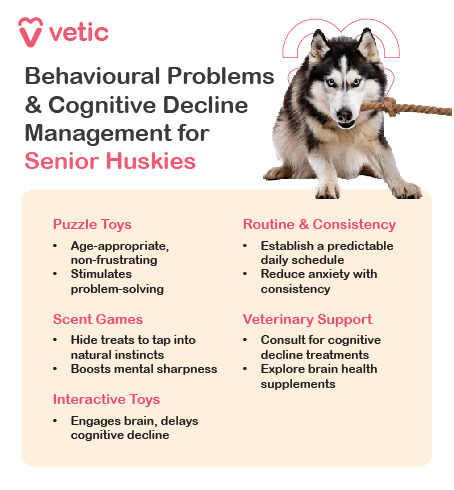
As Huskies age, you may notice certain behavioral changes. Some of these can be attributed to the natural aging process, but they may also be linked to discomfort or underlying health conditions. Addressing these changes early on can significantly improve your senior Husky’s quality of life.
Common Behavioral Issues in Senior Huskies
- Increased Restlessness or Anxiety: Older Huskies may experience increased anxiety, especially when separated from you, or they may seem restless due to pain or cognitive decline. Creating a calm environment, using soothing products like pheromone diffusers, or incorporating consistent calming routines can help reduce anxiety and increase their comfort.
- House Soiling: Senior Huskies may experience incontinence or cognitive decline, which can result in accidents inside the house. If your Husky is having trouble with potty training or accidents are occurring more frequently, provide more frequent potty breaks, especially before bedtime. Consult with your vet to rule out medical conditions such as urinary tract infections, which are common in senior dogs.
- Cognitive Decline (Cognitive Dysfunction Syndrome): Senior Huskies, like all older dogs, are susceptible to cognitive dysfunction, which can manifest as confusion, disorientation, or disrupted sleep patterns. Behavioral signs like excessive barking or whining, getting “stuck” in corners, or pacing may indicate cognitive changes.
Behavioral Training Solutions for Senior Huskies
- Gentle Reinforcement: As your Husky ages, they may become less responsive to traditional training methods. Positive reinforcement with treats, praise, and gentle guidance can encourage desired behaviors. Always reward them for good behavior rather than using punishment, which can increase confusion or anxiety.
- Consistent Routine: Senior Huskies thrive on a predictable daily routine. Consistent feeding times, walks, and rest schedules help provide structure and security, reducing anxiety and making them feel more comfortable in their environment.
- Comfortable Environment: Make sure your senior Husky has a quiet, comfortable resting area away from drafts or loud noises. Consider providing extra bedding or a heating pad if they have joint pain. Keeping their space cozy and familiar can help them relax and feel more secure.
Managing Cognitive Decline in Senior Huskies
Cognitive dysfunction is common in older dogs, but there are strategies to help manage the condition and improve your Husky’s quality of life.
- Brain Games: Engage your senior Husky with mentally stimulating activities like puzzle toys, scent games, or simple obedience exercises to keep their mind sharp. These activities can help slow the progression of cognitive decline.
- Predictable Routine: Like with other behavioral concerns, a consistent routine can be especially helpful for dogs with cognitive dysfunction. Regular feeding, exercise, and sleep schedules will help reduce confusion and anxiety, making them feel more secure.
- Veterinary Support: Consult your veterinarian about supplements or medications that can support brain health and slow cognitive decline. There are various options that may help manage symptoms of aging and improve your Husky’s mental clarity.
Should You Adopt a Husky?
Huskies are not for everyone, but if you’re an active person who loves the outdoors, enjoys training, and can handle a little (or a lot) of stubbornness, they’ll make an amazing companion.
They don’t do well in small apartments unless they get ample exercise, and they’re best suited for people who can commit to their high energy needs and grooming demands.
Huskies thrive with companionship, space to run, and pet parents who understand their independent spirit. If you’re ready for an energetic, affectionate, and sometimes goofy best friend, a Husky might just be the perfect addition to your pack!

